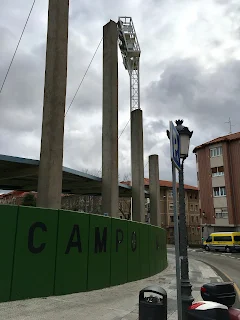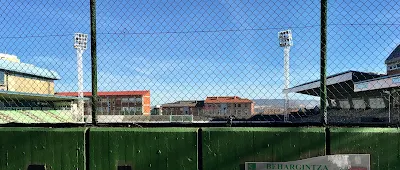Sestao River
Club is a football club who were formed in 1996, following the liquidation of
Sestao Sport Club, who are based in the town of Sestao, which is located on
the south bank of the Nervión, a few miles west of Bilbao in Spain’s Basque
Country.
Sestao Sport
Club was formed in 1916, playing at Campo Municipal de las Llanas. After
competing in local and regional football. Club became members of Tercera
División for the 1929-30 campaign, the third level of Spanish football at the
time.
After the
Spanish Civil War, Sestao played in Segunda División in the 1939-40 season
before dropping down to the third tier after just one season, where they
remained until the end of the 1953-54 season, when they became champions of Grupo
II, winning promotion back to Grupo I of the second tier.
In 1960-61
Club were relegated after losing their play-off game on aggregate to FC
Cartagena. Sestao remained in the Tercera División until 1977-78, when the
leagues were reorganised and Club was placed in Segunda División B.
After a
series of high league finishes in the early 80’s Club were promoted as
champions in 1984-85 to Segunda División. After a few mid-table finishes,
Sestao narrowly escaped relegation in 1991-92, before they went down the
following campaign.
A second-place finish in Grupo II of Segunda División B in 1993-94 saw Club enter the
play-offs, thanks in part to the goalkeeping of Tito Subero, where they missed
out at the group stage. 1994-95 finished happier with a third-place berth, meaning another play-off campaign, thanks to the goals of Aitor Bouzo.
Sestao went
on to win the four-team Grupo A and promotion back to Segunda División as a
reward. However, success came at a price as Club hit severe financial troubles.
Players remained unpaid, and the club was dissolved after finishing in the
relegation play-offs. Sestao River
Club was formed to take Club’s place at Las Llanas to play in the fifth-level
Biscaya División de Honor.
They won promotion in 1998-99 to Grupo IV of the fourth-level Tercera División. A third place in 2000-01 was followed by a runners-up berth in 2001-02. Those seasons set up a platform for the 2003-04 campaign as River were crowned as Grupo IV champions to win promotion to Segunda División B.
River
finished second bottom of the Grupo II table and were relegated just one year
later. However, they bounced straight back to the third tier at the first time
of asking in 2005-06. This time, Sestao were there to stay.
A third-place finish in Grupo IV of Tercera División in 2010-11 led to a place in the playoffs, from where the team won promotion back to the third tier once again. River won the Grupo II title of Segunda División B in 2013-14 to reach the promotion play-offs, thanks to the goals of the league top scorer, Jito.
River missed out on a return to the second tier of Spanish football after drawing 5-5 on aggregate with Albacete, but losing out on away goals. The 2016-17 season ended in relegation
back to the Tercera
División under manager Pablo Turrillas, who was succeeded in November 2017 by Ibón Etxebarrieta. Villar scored the goals as the side reached the playoffs, where they were defeated by Arandina CF.
The goals of Óscar Martín in 2018-19 led Sestao to the playoffs again, where the team progressed to the third round before promotion hopes were dashed by Marino de Luanco. It would be local rivals, Portugalete Club, who caused playoff heartache the following season. 2020-21 was a transitional season for the Spanish league system, and River fared well.
Their performances ensured that the team would be playing in the fourth-tier Segunda División RFEF, thanks to the work of managers Iñaki Pola and then Igor Oca before the appointment of Aitor Calle. Sestao ended in the playoffs in Grupo II, where CD Eldense proved too strong, before the goals of Leandro the following season took Sestao to the title.
This elevated the club to the third-tier Primera Federación Grupo I, where the side consolidated in 2023-24, before being relegated to Segunda Federación the following season with Ángel Viadero and then returning boss Oca taking charge of the team. Calle returned for a second spell in charge in June 2025.
Sestao River
Club will play in Segunda Federación RFEF Grupo II in the 2025-26 season.
My visits
Friday 24th February 2017
My long
weekend in Bilbao and the Biscay region had just begun after landing at Bilbao
Airport, taking a bus into the city and visiting the home of Barakaldo CF. After
taking a train from Urbinaga to Sestao, I came out in a busy and pleasant little
town centre.
Walking past
the Parroquia de Santa María church on Kasko Plaze, I headed uphill on Alameda
las Llanas Kalea with its several local bars and shops. Las Llanas looked like a
substantial and interesting venue, but the gates were locked.
I tried
several places, but there was no way in. I managed to get some shots through
gaps in the fencing before heading round to the far end on Calle San Diego
Kalea. This was below the level of the ground because of the undulating area,
and once again, I had no luck, so I headed off to my next venue, the home of
Portugalete Club.
Saturday 25th February 2017
Being of
stubborn persuasion, I was not going to submit, having not got inside Las
Llanas. I’d contacted a fan through social media who’d liked my initial Tweet
and photos, and he suggested that the ground may be open on Saturday before the
team headed to Arenas Club de Getxo for their local derby.
Once out of
bed, I grabbed a panini and jumped back on the Metro from Abando station and
then retraced my steps when alighting at Sestao. I was out of luck again, but
it wasn’t a total failure.
I’d been a
bit tentative the previous day, but now it was all or nothing. Much to the
astonishment of a group of middle-aged and elderly locals waiting for a coach
trip, I stood on a bench in the street to enable myself to see over the wall
behind the goal and get a view to take photos.
It really
was a stadium full of character. An indoor pelota hall took up space towards
the corner down one side. The rest of the touchline was occupied with a covered
terrace of decent size with a glazed area at the rear. The near goal was open
terracing, as was the far end.
The far side
was taken up by a full-length seated stand, from where I also managed to get
some shots through the side of an exit gate. It was built into a natural hill.
Much of the paintwork was in Sestao’s green and black colours.
Once again, I
had a look all the way around, but that was as good as it was going to get. I
headed back to the Metro to catch a train to Casco Viejo and watch some
football action on top of the hill at Mallona. Sestao was
firmly pencilled in for a home match visit if I ever returned to Bilbao.












No comments:
Post a Comment